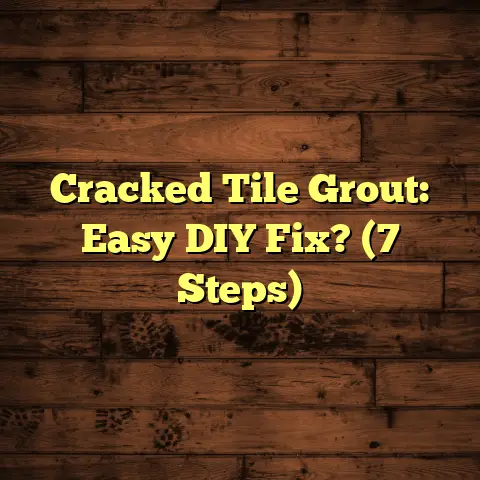Vinyl Tile Grout: Pro Look Tips? (7 Cheap Tricks!)
I’m Tony, and I’ve been slinging tiles and wrangling grout for over 15 years.
And let me tell you, I’ve seen it all – from grout lines that look like a Jackson Pollock painting gone wrong, to mold infestations that could rival a rainforest.
But don’t worry, I’m here to share my hard-earned wisdom with you.
Today, we’re diving deep into the world of vinyl tile grout.
We’re talking about how to get that pro look without breaking the bank.
And more importantly, how to keep your floors healthy and happy.
Because let’s be honest, a clean and well-maintained floor isn’t just about aesthetics.
It’s about creating a healthier living space for you and your family.
Think about it: grout lines are like tiny little highways for dust, allergens, and bacteria.
Yuck, right?
Proper grout application and maintenance can prevent all that nasty stuff from accumulating, contributing to a healthier indoor environment.
We’re talking fewer sniffles, less sneezing, and an overall better quality of life.
So, grab a cup of coffee (or maybe a beer, depending on what time it is!), and let’s get started.
Section 1: Understanding Vinyl Tile and Grout
First things first, let’s make sure we’re all on the same page.
What exactly is vinyl tile, and why is it so darn popular?
Well, vinyl tile is a resilient flooring option made from synthetic materials like PVC (polyvinyl chloride).
It’s basically a fancy type of plastic, but don’t let that fool you.
Vinyl tile is tough, durable, and surprisingly stylish.
I’ve installed it in everything from kitchens and bathrooms to basements and laundry rooms.
It’s a real workhorse.
Here’s why so many people are choosing vinyl tile:
- Durability: It can withstand a lot of foot traffic, scratches, and spills.
- Water Resistance: Perfect for areas prone to moisture.
- Ease of Installation: DIY-friendly, saving you money on professional installation.
- Affordability: Generally less expensive than natural stone or ceramic tile.
- Design Versatility: Available in a wide range of colors, patterns, and textures. You can even find vinyl tile that looks like wood or stone!
Now, let’s talk about grout.
Grout is the material that fills the spaces between the tiles.
Think of it as the glue that holds everything together, both literally and figuratively.
It’s usually made from a mixture of cement, sand, and water.
But there are also epoxy-based grouts, which we’ll get into later.
The role of grout in vinyl tile installations is twofold:
- Structural: It provides stability and support to the tiles, preventing them from shifting or cracking.
- Aesthetic: It enhances the overall appearance of the floor by creating clean lines and smooth transitions.
Without grout, your vinyl tile floor would look unfinished and unprofessional.
Plus, it would be much more susceptible to damage from moisture and dirt.
Section 2: The Importance of Grout in Vinyl Tile Flooring
Okay, so we know what grout is and what it does.
But why is it so important?
Let’s break it down:
-
Moisture Prevention: Grout acts as a barrier, preventing water from seeping under the tiles and damaging the subfloor. This is especially crucial in bathrooms and kitchens, where spills are common.
Think of it like this: your subfloor is like the foundation of your house. If it gets wet, it can lead to mold, rot, and structural problems. Grout helps protect that foundation.
According to the National Association of Home Builders, water damage is one of the most common and costly home repairs.
Properly applied grout can significantly reduce your risk of water damage. * Mold and Mildew Prevention: Mold and mildew thrive in damp, dark environments. If water gets trapped under your tiles, it can create the perfect breeding ground for these nasty organisms.
Grout helps prevent this by creating a watertight seal. But even with grout, it’s important to keep your floors clean and dry.
I recommend using a disinfectant cleaner regularly, especially in areas prone to moisture. * Aesthetic Appeal: Let’s face it, a floor with dirty, cracked grout lines just looks bad. Properly applied grout creates smooth transitions, clean lines, and an overall polished look.
It’s like the finishing touch that transforms a good floor into a great floor.
I’ve seen countless homeowners spend a fortune on beautiful vinyl tiles, only to ruin the effect with sloppy grout work.
Don’t let that be you! * Hygiene and Cleanliness: As I mentioned earlier, grout lines can be a magnet for dirt, dust, and bacteria.
Properly sealed grout makes it easier to clean your floors and keep them hygienic.
I always tell my clients to think of their grout lines like teeth.
You need to brush them regularly (with a good grout cleaner, of course) to prevent plaque buildup.
Section 3: Pro Look Tips for Vinyl Tile Grout
Alright, now for the good stuff.
Here are my top 7 cheap tricks for getting a pro look with your vinyl tile grout:
Tip 1: Choose the Right Grout Color
The color of your grout can dramatically impact the overall look of your flooring.
It’s like choosing the right frame for a piece of art.
The wrong color can clash and distract, while the right color can enhance and complement.
Here are a few things to consider when choosing a grout color:
-
Complementary Colors: If you want your tiles to be the star of the show, choose a grout color that complements them.
For example, if you have light-colored tiles, a light gray or beige grout can create a subtle, elegant look. * Contrasting Colors: If you want to make a bold statement, choose a grout color that contrasts with your tiles.
For example, if you have white tiles, a dark gray or black grout can create a modern, graphic look. * Matching Colors: If you want to create a seamless, uniform look, choose a grout color that matches your tiles as closely as possible.
This is a good option for smaller spaces, as it can make the room feel larger. * Consider the Room: Think about the overall style and ambiance of the room.
A bright, cheerful grout color might be perfect for a kitchen, but it might feel out of place in a formal dining room. * Don’t Be Afraid to Experiment: Order a few different grout samples and test them out with your tiles.
You can even apply a small amount of grout to a scrap piece of tile to see how it looks.
Remember, it’s easier to change your mind before you start grouting!
Tip 2: Use Grout Sealant
Sealing your grout is like applying sunscreen to your skin.
It protects it from the elements and helps it stay healthy and looking good for longer.
Grout sealant is a liquid that penetrates the grout and creates a protective barrier against water, stains, and dirt.
Here’s why you should always seal your grout:
-
Prevents Staining: Grout is porous, which means it easily absorbs liquids and stains.
Sealant helps prevent this by creating a barrier that repels liquids. * Makes Cleaning Easier: Sealed grout is much easier to clean than unsealed grout.
Dirt and grime will simply wipe away, without penetrating the grout. * Extends the Life of Your Grout: By protecting it from water and stains, sealant helps extend the life of your grout.
This means you won’t have to regrout as often, saving you time and money. * Prevents Mold and Mildew Growth: Sealant helps prevent water from seeping into the grout, which can inhibit mold and mildew growth.
I recommend applying grout sealant within a week of installing your vinyl tile floor.
And then reapplying it every 1-2 years, depending on the traffic and moisture levels in the area.
Tip 3: Maintain Grout Lines Regularly
Even with sealant, it’s important to clean and maintain your grout lines regularly.
Think of it like brushing your teeth.
You wouldn’t just brush them once a year, would you?
Here are a few tips for keeping your grout lines clean:
- Sweep or Vacuum Regularly: This will remove loose dirt and debris that can accumulate in the grout lines.
-
Mop with a Neutral Cleaner: Use a pH-neutral cleaner specifically designed for tile and grout.
Avoid using harsh chemicals or abrasive cleaners, as they can damage the grout. * Spot Clean Stains: If you notice a stain, try to clean it up as soon as possible.
You can use a grout brush and a mild cleaner to scrub the stain.
For tougher stains, you can try a mixture of baking soda and water or a commercial grout cleaner. * Deep Clean Periodically: Every few months, give your grout lines a deep cleaning.
You can use a steam cleaner or a grout brush and a stronger cleaner to remove stubborn dirt and grime. * Consider a Grout Pen: A grout pen is a marker-like tool that allows you to touch up stained or discolored grout lines.
It’s a quick and easy way to brighten up your floor and make it look new again.
Tip 4: Opt for Epoxy Grout
If you’re looking for the ultimate in durability and stain resistance, consider using epoxy grout.
Epoxy grout is a two-part system that consists of epoxy resin and a hardener.
When mixed together, these two components create a super- strong, waterproof grout that is resistant to stains, chemicals, and bacteria.
Here are some of the benefits of epoxy grout:
-
Superior Stain Resistance: Epoxy grout is virtually stain-proof.
It can withstand spills from coffee, wine, grease, and other common household substances. * Waterproof: Epoxy grout is completely waterproof, making it ideal for showers, bathrooms, and other wet areas. * Chemical Resistance: Epoxy grout is resistant to a wide range of chemicals, including acids, alkalis, and solvents. * Bacteria Resistance: Epoxy grout is non-porous, which means it doesn’t harbor bacteria or mold. * Long-Lasting: Epoxy grout is incredibly durable and can last for many years without cracking, crumbling, or discoloring.
The downside of epoxy grout is that it’s more expensive and more difficult to install than traditional cement-based grout.
But if you’re willing to invest the extra time and money, it’s well worth it.
Tip 5: Employ a Grout Float for Application
Using the right tools can make a big difference in the quality of your grout job.
A grout float is a rectangular tool with a rubber or foam pad that is used to apply grout to the tile joints.
Here’s why you should use a grout float:
- Even Application: A grout float allows you to apply the grout evenly and consistently, ensuring that all the joints are filled properly.
- Smooth Finish: A grout float helps to create a smooth, professional-looking finish.
- Reduced Waste: A grout float helps to reduce waste by allowing you to apply the grout precisely where you need it.
- Easy to Use: Grout floats are easy to use, even for beginners.
When using a grout float, hold it at a 45-degree angle to the tile surface and apply the grout in a sweeping motion.
Be sure to press firmly to force the grout into the joints.
Tip 6: Consider Grout Width
The width of your grout lines can affect both the aesthetics and the functionality of your floor.
Wider grout lines can create a more rustic, textured look, while narrower grout lines can create a more modern, seamless look.
Here are a few things to consider when choosing a grout width:
- Tile Size: Larger tiles generally require wider grout lines to accommodate for slight variations in size and shape.
- Tile Type: Some types of tiles, such as handmade or irregular tiles, may require wider grout lines to accommodate for their unique characteristics.
-
Personal Preference: Ultimately, the width of your grout lines is a matter of personal preference.
Choose a width that you find aesthetically pleasing.
As a general rule of thumb, I recommend using a grout width of at least 1/8 inch for most vinyl tile installations.
Wider grout lines can also be beneficial in certain situations.
For example, if you have a floor that is prone to movement or settling, wider grout lines can help to prevent cracking.
Tip 7: Color Enhancing Grout
If you want to take your vinyl tile floor to the next level, consider using color-enhancing grout.
Color-enhancing grout is a type of grout that is designed to enhance the natural colors and textures of your tiles.
It contains special pigments that penetrate the tile surface and bring out its inherent beauty.
Here are some of the benefits of color-enhancing grout:
- Enhances Tile Colors: Color-enhancing grout can make your tiles look richer, more vibrant, and more appealing.
- Highlights Texture: Color-enhancing grout can highlight the texture and pattern of your tiles, adding depth and dimension to your floor.
- Creates a Custom Look: Color-enhancing grout allows you to create a custom look that is unique to your home.
Color-enhancing grout is available in a wide range of colors, so you can find the perfect match for your tiles.
It’s also relatively easy to apply, although it does require a bit more care and attention than traditional grout.
Section 4: Cost-Effective Solutions for Grout Issues
Okay, so you’ve followed all my tips and tricks, and your vinyl tile floor looks amazing.
But what happens when grout problems inevitably arise?
Don’t panic!
There are plenty of cost-effective solutions for common grout issues, such as discoloration and cracking.
Here are a few of my favorite DIY fixes:
-
Discoloration: For minor discoloration, try scrubbing the grout lines with a mixture of baking soda and water.
Apply the paste to the grout lines, let it sit for a few minutes, and then scrub with a grout brush.
Rinse with clean water.
For tougher stains, you can try a commercial grout cleaner or a mixture of bleach and water (use caution when working with bleach). * Cracking: For small cracks, you can try filling them with a grout repair kit.
These kits typically contain a small amount of grout and a applicator tool.
Simply apply the grout to the crack, smooth it out with the tool, and let it dry.
For larger cracks, you may need to remove the old grout and replace it with new grout.
This is a more involved process, but it’s still relatively easy to do yourself. * Mold and Mildew: For mold and mildew, try scrubbing the grout lines with a mixture of bleach and water.
Apply the solution to the grout lines, let it sit for a few minutes, and then scrub with a grout brush.
Rinse with clean water.
Be sure to ventilate the area well when working with bleach.
If you’re not comfortable tackling these repairs yourself, you can always hire a professional.
But with a little bit of elbow grease and the right materials, you can save yourself a lot of money by doing it yourself.
Section 5: Conclusion
So, there you have it: my top 7 cheap tricks for getting a pro look with your vinyl tile grout.
I hope you found these tips helpful and informative.
Remember, maintaining your vinyl tile grout isn’t just about aesthetics.
It’s about creating a healthier, cleaner, and more enjoyable living space for you and your family.
By choosing the right grout color, sealing your grout, cleaning it regularly, and addressing any issues promptly, you can keep your floors looking their best for years to come.
And who knows, you might even impress your friends and neighbors with your newfound grout expertise!
Now go forth and conquer those grout lines!
And if you have any questions or comments, feel free to leave them below.
I’m always happy to help.





